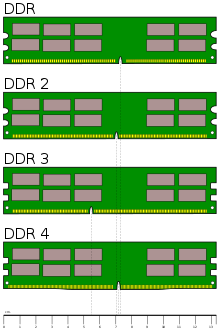| Computer memory and data storage types |
|---|
| Volatile |
| Non-volatile |
 Comparison of DDR modules for desktop PCs (DIMM) | |
 Front and back of a 1GB DDR-400 RAM module for desktop PCs (DIMM) | |
| Developer | |
|---|---|
| Type | Synchronous dynamic random-access memory |
| Generations | |
| Release date |
|
| Specifications | |
| Voltage |
|
Double Data Rate Synchronous Dynamic Random-Access Memory (DDR SDRAM) is a double data rate (DDR) synchronous dynamic random-access memory (SDRAM) class of memory integrated circuits used in computers. DDR SDRAM, also retroactively called DDR1 SDRAM, has been superseded by DDR2 SDRAM, DDR3 SDRAM, DDR4 SDRAM and DDR5 SDRAM. None of its successors are forward or backward compatible with DDR1 SDRAM, meaning DDR2, DDR3, DDR4 and DDR5 memory modules will not work on DDR1-equipped motherboards, and vice versa.
Compared to single data rate (SDR) SDRAM, the DDR SDRAM interface makes higher transfer rates possible through more strict control of the timing of the electrical data and clock signals. Implementations often have to use schemes such as phase-locked loops and self-calibration to reach the required timing accuracy.[4][5] The interface uses double pumping (transferring data on both the rising and falling edges of the clock signal) to double data bus bandwidth without a corresponding increase in clock frequency. One advantage of keeping the clock frequency low is that it reduces the signal integrity requirements on the circuit board connecting the memory to the controller. The name "double data rate" refers to the fact that a DDR SDRAM with a certain clock frequency achieves nearly twice the bandwidth of a SDR SDRAM running at the same clock frequency, due to this double pumping.
With data being transferred 64 bits at a time, DDR SDRAM gives a transfer rate (in bytes/s) of (memory bus clock rate) × 2 (for dual rate) × 64 (number of bits transferred) / 8 (number of bits/byte). Thus, with a bus frequency of 100 MHz, DDR SDRAM gives a maximum transfer rate of 1600 MB/s.
- ^ "Samsung 30 nm Green PC3-12800 Low Profile 1.35 V DDR3 Review". TechPowerUp. March 8, 2012. Retrieved 25 June 2019.
- ^ "Samsung Electronics Comes Out with Super-Fast 16M DDR SGRAMs". Samsung. 17 September 1998. Retrieved 23 June 2019.
- ^ Cite error: The named reference
physwas invoked but never defined (see the help page). - ^ Northwest Logic DDR Phy datasheet Archived 2008-08-21 at the Wayback Machine
- ^ "Memory Interfaces Data Capture Using Direct Clocking Technique (Xilinx application note)" (PDF). xilinx.com.